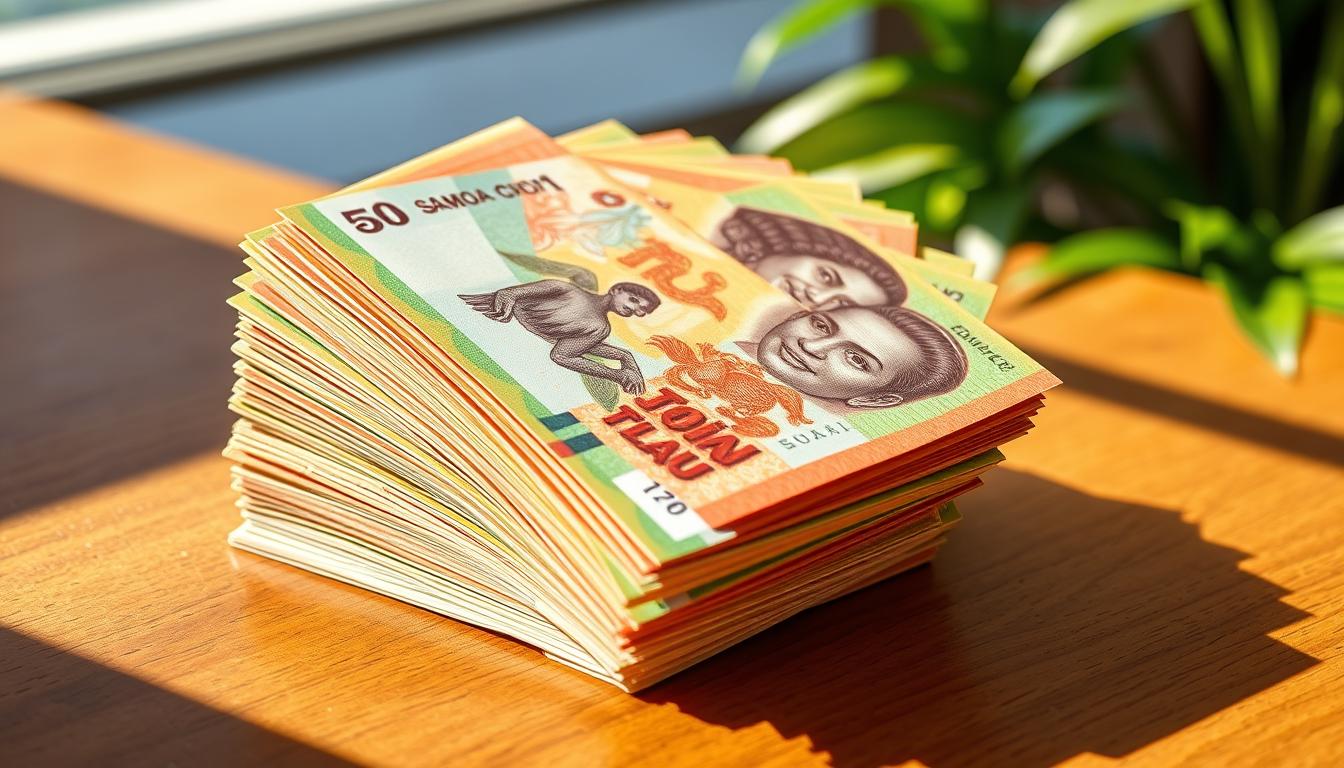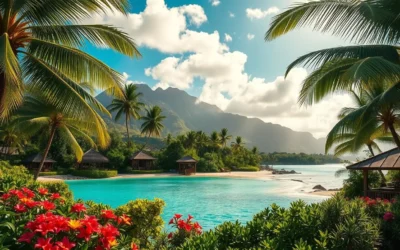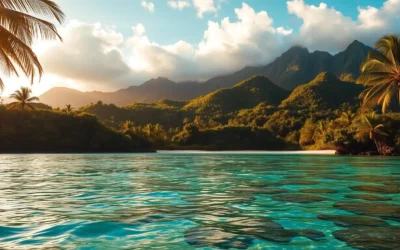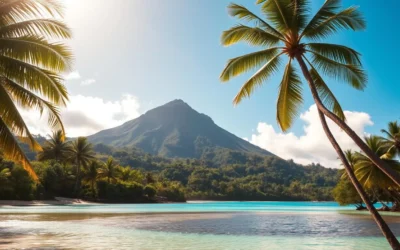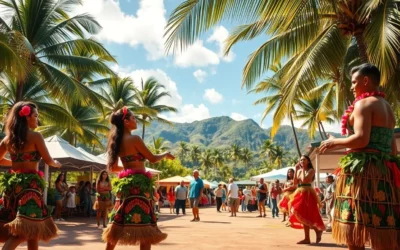✓ Accommodations✓ Flights✓ Rental Cars✓ Tours & Activities
Did you know that the Samoan tālā (WST) has been the official currency of this South Pacific island since 1967? If you’re planning a trip from the United States, understanding how to handle money here is essential for a smooth experience.
The local currency comes in both coins (sene) and banknotes, ranging from 10 sene to ST$100. While credit cards are accepted in some places, cash is king in local markets and smaller establishments. This means you’ll need to exchange your dollars before or upon arrival.
This guide will help you navigate the best ways to manage your money, from ATMs to currency exchange services. Whether you’re exploring Apia or venturing to remote areas, being prepared will make your trip stress-free and enjoyable.
Understanding Samoa’s Currency and Payment Systems
The Samoan tālā (WST) has a rich history that reflects the island’s cultural heritage. Introduced in 1967, it replaced the New Zealand dollar and became a symbol of Samoa’s independence. The tālā’s name is derived from the English word “dollar,” but its design is uniquely Samoan, showcasing the country’s traditions and artistry.
History of the Samoan Tālā and Its Significance
Before the tālā, Samoa used the New Zealand dollar as its official currency. The shift to the tālā marked a significant step in the nation’s journey toward self-reliance. The colorful banknotes and coins feature iconic landmarks, cultural symbols, and historical figures, making them a visual representation of Samoa’s identity.
Currency Denominations and Local Payment Practices
The tālā comes in coins (sene) and banknotes, ranging from 10 sene to ST$100. While credit cards are accepted in hotels and larger establishments, cash is king in local markets and smaller shops. This is especially true in rural areas, where digital payment options are less common.
“Carrying cash ensures you’re prepared for any transaction, whether you’re buying fresh produce at a market or paying for a taxi ride.”
Exchange options are available at banks and money changers in Apia, the capital city. It’s a good idea to exchange your currency before venturing to remote areas. Here’s a quick overview of the denominations:
| Type | Denominations |
|---|---|
| Coins | 10 sene, 20 sene, 50 sene, $1, $2 |
| Banknotes | $5, $10, $20, $50, $100 |
While modern payment methods like credit cards and mobile wallets are gaining traction, cash remains the preferred way to pay in many places. This blend of tradition and innovation makes managing your money an interesting part of your trip.
Samoa: Ultimate Travelers Guide to Currencies & Payments
From cash to cards, here’s how to navigate the island’s payment systems. This guide covers everything from the history of the local currency to modern payment methods, ensuring you’re well-prepared for every transaction.
Whether you’re exploring bustling markets or relaxing on pristine beaches, understanding your options is key. Here’s what you need to know:
- Cash is essential for smaller shops and rural areas.
- Cards are widely accepted in hotels and larger establishments.
- ATMs are available in urban centers, but fees may apply.
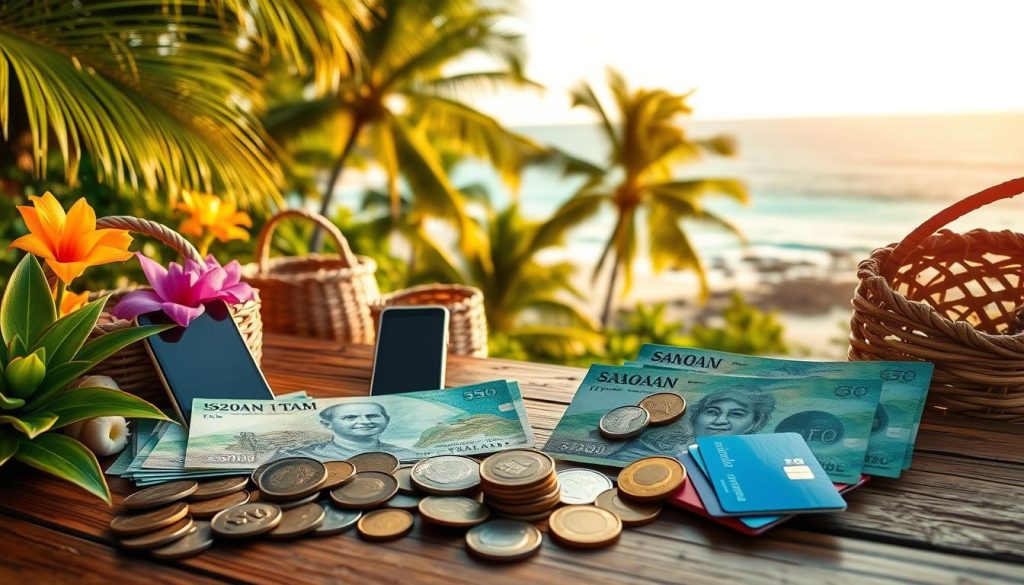
This section acts as a transition to more detailed discussions on travel money cards and ATM access. By the end of this guide, you’ll have a clear understanding of how to manage your finances efficiently.
Planning your budget? The average daily cost for travel here is around $120, covering meals, transport, and activities. This guide is designed to help you make the most of your trip without overspending.
Ready to dive deeper? Let’s explore the best ways to access cash and use cards during your stay.
Preparing for Currency Exchange: Buying Samoan Tālā Before Your Trip
Planning your trip? Getting your currency sorted early can save you time and money. Arranging your Samoan tālā in advance ensures you’re ready to explore without worrying about last-minute exchanges.
Online Orders vs. Airport Exchanges
Online currency providers like S Money often offer the best exchange rates. You can order your tālā online and have it delivered to your home or picked up at a convenient location. This option is not only cost-effective but also saves you time.
On the other hand, exchanging currency at the airport is convenient but often comes with higher fees and poorer rates. Airport bureaux de change are known for their lower exchange rates, which can eat into your travel budget.
Benefits of Arranging Your Currency in Advance
Buying your tālā before your trip has several advantages. First, it helps you avoid the stress of finding an exchange service upon arrival. Second, you’ll have cash on hand for immediate expenses like transportation or meals.
Here’s why advanced preparation is a smart move:
- Better rates: Online providers often offer more competitive exchange rates than airport services.
- Lower fees: Avoid unnecessary charges by arranging your currency in advance.
- Peace of mind: Having cash ready ensures a smooth start to your trip.
By planning ahead, you can focus on enjoying your journey instead of worrying about money. Whether you choose an online provider or a local bank, preparing your currency early is a simple way to enhance your travel experience.
Accessing Cash and ATM Services in Samoa
Managing your money while exploring this South Pacific island is easier when you know where to find ATMs. Whether you’re in the bustling capital or a quiet village, understanding the availability and fees of ATMs ensures a smooth experience.
Finding Reliable ATMs in Urban and Rural Areas
In urban centers like Apia, ATMs are widely available. Banks such as ANZ and BSP operate multiple machines, making it convenient to withdraw cash. However, in rural areas, ATMs are scarce, so it’s wise to plan ahead.
At Faleolo Airport, you’ll find ATMs for immediate cash needs. But if you’re heading to remote regions, consider withdrawing enough money in advance. This ensures you’re prepared for day-to-day purchases in local markets and small vendors.
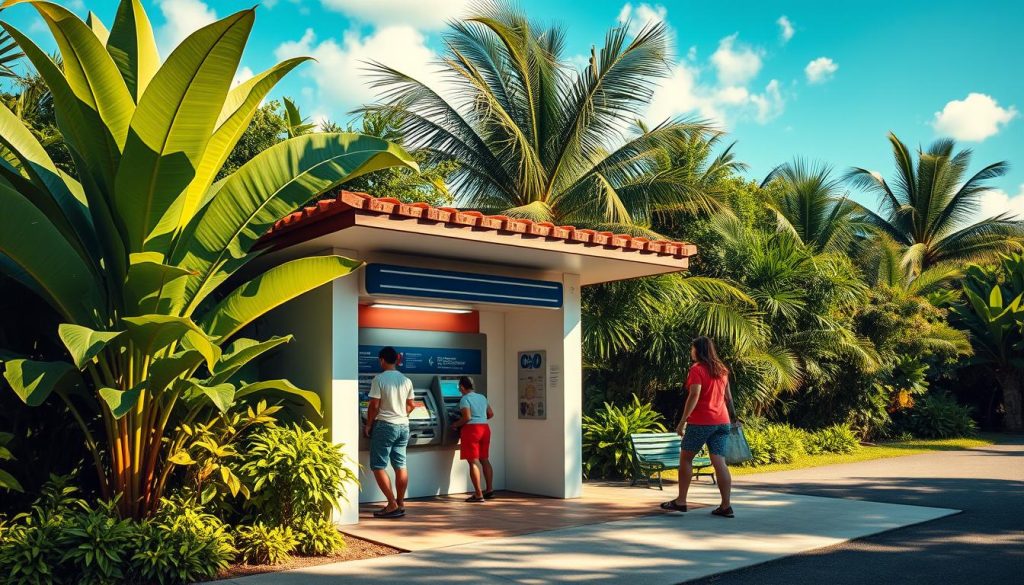
Understanding Withdrawal and Conversion Fees
Withdrawal fees for international cards typically range from ST$5 to ST$16 per transaction. Additionally, your bank may charge conversion fees for foreign transactions. To avoid surprises, check with your bank before traveling.
Here are some tips to minimize fees:
- Notify your bank: Inform them of your travel dates to prevent card freezes.
- Withdraw larger amounts: This reduces the number of transactions and associated fees.
- Compare rates: Some banks offer better exchange rates than others.
“Carrying cash ensures you’re ready for any transaction, whether you’re buying fresh produce at a market or paying for a taxi ride.”
By planning your cash needs and understanding ATM services, you can focus on enjoying your trip without financial stress. This South Pacific island offers a unique blend of tradition and modernity, and being prepared makes all the difference.
Maximizing Your Bank and Travel Money Cards
Choosing the right card for your trip can make managing your money abroad a breeze. Whether you prefer debit or credit cards, understanding their pros and cons helps you avoid unnecessary fees and stay in control of your spending.
Debit Cards: Pros, Cons, and Fee Considerations
Debit cards are a popular choice for travelers because they allow direct access to your bank account. They’re great for daily expenses and ATM withdrawals. However, they often come with fees for international transactions and foreign ATM withdrawals.
Here’s what to keep in mind:
- Pros: No interest charges, easy budgeting, and widespread acceptance.
- Cons: Foreign transaction fees (1%-3%), ATM withdrawal fees, and limited fraud protection.
Travel-friendly options like Wise and Revolut offer multi-currency accounts and lower fees, making them ideal for frequent travelers.
Credit Cards: When to Use Them for Overseas Transactions
Credit cards are perfect for larger purchases, hotel bookings, and emergencies. Many cards, like Bankwest Platinum and 28 Degrees, waive foreign conversion fees, saving you money on international transactions.
Here’s why credit cards are advantageous:
- Rewards: Earn points or cashback on purchases.
- Security: Strong fraud protection and easy dispute resolution.
- Convenience: Use for online bookings and contactless payments.
“Using a credit card for hotel stays or car rentals often provides additional insurance coverage, giving you peace of mind.”
Remember to notify your bank before traveling to avoid card freezes and always check for hidden fees.
Whether you choose a debit or credit card, having one with 24/7 app management ensures you’re always in control. Analyze your spending habits and pick the card that best fits your travel needs.
Top Travel Money Cards for Samoan Adventures
When planning your next adventure, having the right travel money card can make all the difference. Whether you’re exploring bustling cities or remote villages, the right card ensures smooth transactions and minimal fees. Let’s dive into the top options available for travelers.
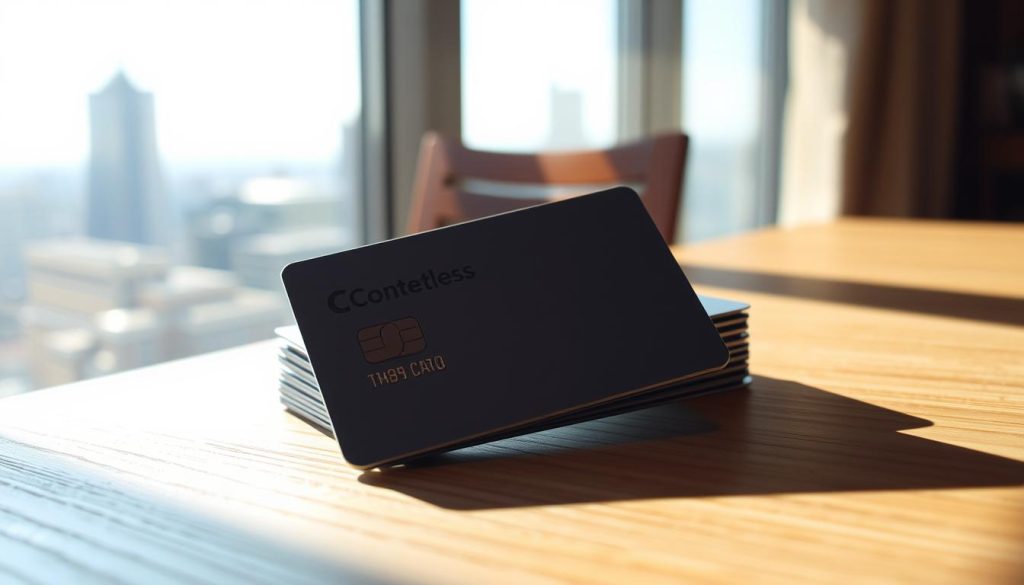
Wise Multi-Currency Card Overview
The Wise Multi-Currency Card is a favorite among frequent travelers. It offers mid-market exchange rates, which are often better than traditional banks. You can hold and convert over 50 currencies, making it ideal for multi-destination trips.
One standout feature is the ability to withdraw up to $250 per month from ATMs without fees. Beyond that, a small fee applies, but it’s still competitive. The card also supports contactless payments, adding convenience to your travels.
Comparing Chime, Monzo, and Netspend Options
Chime is another excellent choice, especially for U.S. travelers. It promises no foreign transaction fees, making it a budget-friendly option. However, be aware of the $2.5 out-of-network ATM fee if you’re not using their partner ATMs.
Monzo is known for its user-friendly app and real-time spending notifications. It’s great for tracking expenses on the go. While it charges a small fee for ATM withdrawals abroad, its transparency and ease of use make it a top contender.
Netspend offers prepaid card options, which are perfect for those who want to control their spending. It’s widely accepted and comes with a mobile app for easy management. However, it does have higher fees for international transactions compared to other cards.
“Choosing the right card depends on your travel style and spending habits. Whether you prioritize low fees or convenience, there’s an option for you.”
Here’s a quick comparison to help you decide:
| Card | Key Features | Fees |
|---|---|---|
| Wise | Mid-market rates, multi-currency support | Free ATM withdrawals up to $250/month |
| Chime | No foreign transaction fees | $2.5 out-of-network ATM fee |
| Monzo | Real-time spending notifications | Small ATM withdrawal fee abroad |
| Netspend | Prepaid, spending control | Higher international transaction fees |
Before your trip, order your card early to allow time for delivery and activation. Check for any hidden fees and notify your bank of your travel dates to avoid card freezes. With the right card in hand, you’re ready to explore with confidence.
Embracing Digital and Mobile Payments in Samoa
As technology advances, digital and mobile payment options are becoming more accessible in Samoa. This shift offers travelers added convenience, especially in urban areas where contactless payments are gaining traction.
Mobile wallets like Apple Pay and Google Pay are now accepted in many hotels and larger establishments. These options not only speed up transactions but also enhance security by reducing the need to carry physical cards or cash.
Contactless Payments and Mobile Wallet Trends
Contactless payments are transforming the way transactions are handled in Samoa. Many businesses, especially in Apia, now accept tap-and-go payments, making it easier for tourists to pay for meals, souvenirs, and services.
Using a mobile wallet allows you to manage your spending on the go. Apps provide real-time notifications, helping you track expenses and stay within budget. This is particularly useful for travelers who want to avoid overspending.
Here are some benefits of using digital payments:
- Speed: Transactions are faster compared to traditional methods.
- Security: Reduced risk of losing cash or cards.
- Convenience: No need to carry large amounts of cash.
Despite the rise of digital options, carrying some cash remains essential. Smaller vendors and rural areas may not yet support mobile payments, so it’s wise to have both options available.
Setting Up Your Mobile Payment Apps
Before your trip, ensure your mobile payment apps are set up and linked to your bank account. Check for any international transaction fees and notify your bank of your travel dates to avoid card freezes.
Here’s a quick comparison of popular mobile payment options:
| Option | Key Features | Fees |
|---|---|---|
| Apple Pay | Contactless, secure, widely accepted | No additional fees |
| Google Pay | Real-time notifications, multi-device support | No additional fees |
| Samsung Pay | Works with older card readers, secure | No additional fees |
By embracing digital and mobile payments, you can enjoy a smoother and more secure travel experience in Samoa. Just remember to keep some cash handy for places where technology hasn’t yet caught up.
Destination Insights: Where to Exchange and Withdraw Money Safely
Navigating the financial landscape of a new destination can be tricky, but knowing where to exchange and withdraw money safely makes all the difference. In this South Pacific country, trusted locations like banks and money changers ensure you get the best rates and avoid unnecessary fees.
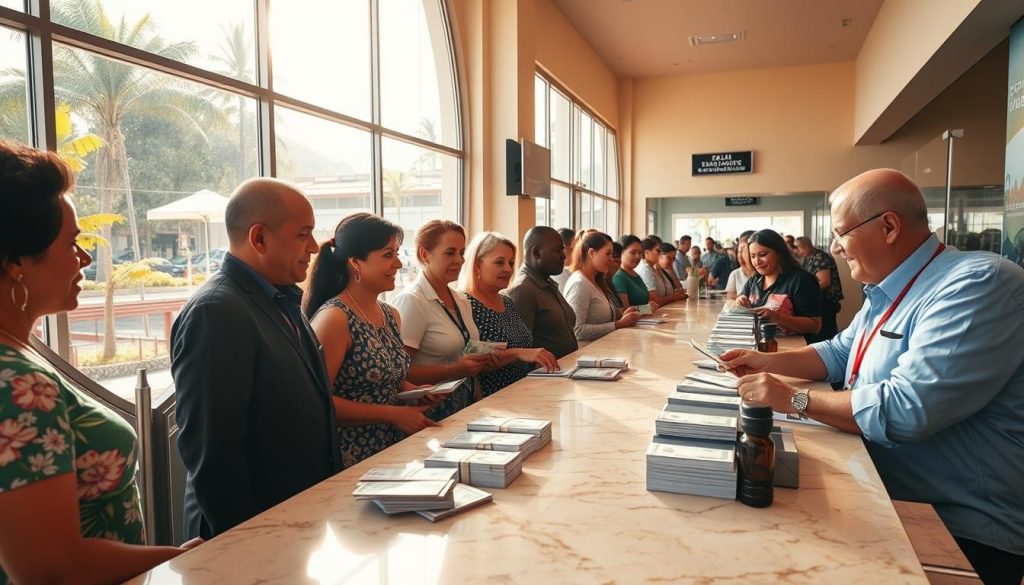
Recommended Money Changer and Bank Locations
For reliable exchange services, head to Apia, the capital city. Major banks like ANZ and BSP offer secure transactions and competitive rates. Money changers at Apia International Airport are also convenient, though their rates may be less favorable.
Here’s where you can safely exchange your currency:
- ANZ Bank: Multiple branches in Apia with low fees.
- BSP Bank: Known for reliable service and fair exchange rates.
- Airport Money Changers: Convenient but check rates before exchanging.
In rural areas, options are limited. Plan ahead by withdrawing enough cash in urban centers. ATMs are scarce outside Apia, Faleolo Airport, and major tourist spots.
“Always compare exchange rates and fees to ensure you’re getting the best deal. A little research can save you money and hassle.”
Here’s a quick comparison of exchange options:
| Location | Pros | Cons |
|---|---|---|
| ANZ Bank | Low fees, secure | Limited rural access |
| BSP Bank | Fair rates, reliable | Fewer branches |
| Airport Changers | Convenient | Higher fees |
For a smooth experience, check current exchange rates before heading out. This ensures you’re prepared and can make informed decisions. Whether you’re in the city or exploring the islands, being financially prepared enhances your travel experience.
Essential Budgeting and Daily Expense Planning for Samoa
Budgeting for your trip to this South Pacific island ensures a stress-free experience. Knowing how much to allocate for meals, transport, and activities helps you make the most of your time. Here’s a breakdown of daily costs to guide your planning.
Sample Daily Budget and Local Cost Estimates
On average, a tourist spends around $120 per day. This includes meals, transport, and activities. Here’s how it breaks down:
- Food: A meal at a local restaurant costs $15-$30, while street food is $5-$10.
- Transport: Taxi fares range from $60-$80 for airport transfers, and local buses cost $0.50-$12 per trip.
- Accommodation: Budget hotels start at $120 per night, while beach fales are $40-$50 per person.
- Activities: Snorkeling or cultural tours cost $20-$100, depending on the experience.
In rural areas, costs are generally lower. For example, meals at small eateries can be as low as $5, and transport options like buses are cheaper. However, activities may be limited compared to urban centers like Apia.
Carrying cash is essential for smaller vendors and rural transactions. While cards are accepted in hotels and larger establishments, cash ensures you’re prepared for any situation. A travel money card can also help manage expenses and avoid unnecessary fees.
“Planning your budget in advance allows you to enjoy your trip without financial stress. Whether you’re exploring markets or relaxing on the beach, knowing your expenses keeps you in control.”
Here are some practical tips for budgeting:
- Withdraw cash in urban areas where ATMs are more accessible.
- Compare prices for activities and meals to find the best deals.
- Use a travel money card for larger purchases to avoid carrying too much cash.
By planning ahead and understanding local costs, you can enjoy a seamless and enjoyable experience in this beautiful island nation.
Insider Tips for Smooth Transactions and Sustainable Travel Practices
Ensuring smooth transactions during your trip involves more than just carrying cash. By understanding local customs and adopting eco-friendly practices, you can protect the island’s natural beauty while avoiding common pitfalls.
Sustainable Payment Methods to Protect Samoa’s Ecosystems
Choosing eco-friendly payment methods can make a big difference. Digital payments like mobile wallets reduce the need for physical cash, which often leads to waste. Apps like Apple Pay and Google Pay are widely accepted in urban areas, offering a secure and convenient way to pay.
Here are some sustainable tips:
- Use digital payments: Minimize cash usage to reduce waste.
- Carry reusable items: Avoid single-use plastics by bringing your own bags and bottles.
- Support local businesses: Many small vendors prefer cash, but ask if they accept digital payments to reduce paper waste.
By making small changes, you can contribute to preserving the island’s ecosystems.
Local Customs and Strategies for Avoiding Transaction Pitfalls
Understanding local customs can help you avoid hidden fees and outdated practices. Always verify the current exchange rate before exchanging money. Airport counters often charge higher fees, so opt for banks or online providers for better rates.
Here’s how to navigate transactions smoothly:
- Check fees: Be aware of ATM withdrawal and foreign transaction fees.
- Ask locals for advice: They can guide you to reliable exchange services.
- Use travel money cards: These often offer better rates and lower fees compared to credit cards.
“Respecting local customs and being mindful of fees ensures a hassle-free experience.”
By following these tips, you can enjoy your trip while supporting sustainable practices and avoiding financial pitfalls.
Conclusion
Smart preparation is the key to a smooth and enjoyable trip. By understanding local payment systems and planning ahead, you can avoid unnecessary stress. Pre-buying currency, using reliable travel cards, and embracing digital payments are all great ways to stay in control of your finances.
Budgeting wisely ensures you make the most of your journey without overspending. Remember to carry some cash for smaller vendors and rural areas, while relying on cards for larger purchases. Sustainable practices, like minimizing cash usage, also help protect the environment.
Use this guide as a checklist to ensure seamless transactions throughout your adventure. With careful planning, you can focus on creating unforgettable memories. Thank you for exploring this comprehensive resource, and we wish you safe and happy travels!
The above is subject to change.
Check back often to TRAVEL.COM for the latest travel tips and deals.
